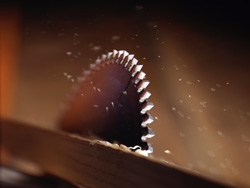Nano-powder ceramics as an alternative to metals
Cutting tools, gears and bearings are typically made of metal parts. Ceramic nanopowders offer great potential as an alternative to metal for production of wear-resistant wood cutting tools as well as parts for medical technology, micro-reactors and micro-sensors. To exploit their potential, European researchers supported by funding of the ‘Cutting tools and miniaturised parts with complex geometry based on nano powders’ (Nanoceram) project set out to develop plasma chemical technology for nanopowder manufacture as well as new technologies for surface modifications of the powders for use in standard gel casting, injection moulding and pressing. In addition, they sought to develop sintering methods for producing dense materials with nano-sized microstructure. In particular, researchers focused on the use of silicon nitride (Si3N4) for wood cutting tools and yttria (Y)-stabilised zirconium oxide (ZrO2) for parts in medical technology and micro-devices. Investigators successfully produced four batches of plasma-processed Si3N4 powders of required quality and quantity. In addition, they carried out surface modifications of the nano-sized powders to achieve good particle dispersion and high solid loads. A gel casting procedure was developed for manufacture of parts from pure Si3N4 plasma powder or mixtures of it. Manufactured plates were free of defects with excellent bending strength, hardness and fracture toughness. Additionally, parts shaped from Si3N4 plasma powder or mixtures of it via gel casting, metal powder injection moulding (MPIM) and cold isostatic pressing (CIP) were then sintered to optimise sintering regimes. Milling cutters produced from Si3N4 were tested against hard metal cutters. Although the ceramic cutters produced flakes or fragments, field emission scanning electron microscopy of the edges detected no damage after grinding. Nanoceram has developed valuable new technology that can enable the production of wood cutting, medical and micro-devices from nanopowder ceramics using standard shaping methods including gel casting, injection moulding and pressing.



